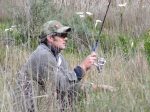Species Information#2: Leerfish: The Early Inspiration
Leerfish (Lichia amia)
Fishing for Leerfish (or Leervis in South Africa) off the Hermanus Coast was one of Steve’s earliest fishing inspirations. Steve and Andy spent copious hours of night fishing in search of this game fish.
Leerfish are found in the Atlantic, Pacific, Indian Oceans, and in the Mediterranean Sea. Leerfish is one many common names for this fish, other Akya, Garrick and Leervis. Leerfish are members of the Jack family. They are normally found in small groups in summer periods, usually less than 10 fish, and can be found in larger groups during the winter season. They come close to shore in search of mullet, shad and bluefish.
Leerfish are part of the Family/Order/Class of Carangidae (Jacks and Pompanos) and the sub-family of Perciformes/Actinopterygii (ray-finned fishes). For more information see The Aquatic Dictionary: http://www.aquaticdictionary.com/dictionary/define.asp?term=Lichia%20amia
According to the South African Institute for Aquatic Biodiversity (SAIAB), the prized angling and spearfishing species is known as Leervis in Cape waters and as Garrick in KwaZulu-Natal and along the Transkei Wild Coast. Leervis have a compressed elongated body and a large mouth. The head and body are blue-grey to greenish above and silvery white below, while the fins are dark. Leervis occur from the Mediterranean Sea, along the west African coast, right round South Africa to Maputo. Adults are found near shore in clear surface waters, from the surf zone to 50m. Juveniles are dependent on estuaries as nursery areas. Small juveniles (10-15cm) feed on shrimps and fish, and are able to swallow prey 70% of their own length. Larger juveniles (up to 30cm) feed mainly on estuarine fish such as mullet. Leervis are mature at about 85cm (about 3-4 years old) and grow to about 190cm and an age of about 10 years. Leervis migrate up the east coast of South Africa with the annual ‘sardine run’ during winter months. Most Leervis spawn along the KwaZulu-Natal coast from September to November, after which they migrate back to Cape waters.
See the SAIAB Coastal Fishery Resources- an easy guide http://www.saasta.ac.za/downloads/pdfs/booklet_coastal_fish_2004.pdf
According to the Cape Piscatorial Society (http://www.piscator.co.za) the “Leerfish is one of the first Cape saltwater fish targeted by flyanglers. They fall readily to poppers and streamers, and the juveniles although below legal limits for keeping, offer wonderful sport to the light tackle and fly angler. Fish up to 25lbs have been taken on fly. Suitable flies for Leerfish include White poppers, woolhead mullets, clouser minnows, Lefty’s deceivers. Don’t neglect smaller flies; juveniles in particular will often take a smaller pattern over a larger one.”
Species Status in South Africa
According to the Department of Environmental Affairs and Tourism, the Leerfish is on the prohibited species list and may not be sold or purchased by any person as these fish stocks are considered to have collapsed and are subject to various recovery strategies. For more information please see The Guide for Restaurants Intending to Sell Fish online at http://www.environment.gov.za/Branches/MarineCoastal/AreasWork/restaurant_guidelines/guide_for_restaurants.pdf)
Legal Catch in South Africa
Minimum Legal Size: 700mm/70cm
Bag Limit: 2 (bag limit refers to the maximum number of fish. either in respect of individual species or of total catch of fish which may be caught on any one day or kept in the possession or control of any person.).
Measurement Requirement: Fork Length
See SA Government Gazette No. 27453 Marine Living Resources Act, 1998 (Act No. 18 of 1998) Amendments to Regulations Published in terms of the Marine Living Resources Act, 1998: GN Regulation 1111 of 2 September 1998 http://www.info.gov.za/gazette/notices/2005/27453.pdf
No comments yet.

Leave a comment